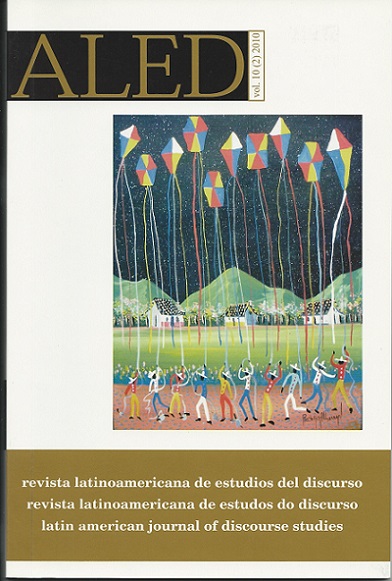Premio CAB Somos Patrimonio
Construcción discursiva de la identidad cultural venezolana en un contexto internacional
Keywords:
systemic functional grammar. appraisal theory. cultural identity. intangible cultural heritage. cultural organizations.Abstract
We present the results of the analysis of the written texts produced by eleven (11) Venezuelan cultural organizations and submitted for their nomination in an international competition. Based on Systemic Functional Grammar (Halliday, 1984) and Appraisal Theory (White, 2000) we set out to study the construction of cultural identity. Thus, we identified how people who write on behalf of organizations present themselves as well as the ways in which the semantic processes in the text are related to their activity and how their relationship with others is expressed. The results show that organizations often present themselves as promoters of their intangible cultural heritage. Under no circumstances do they present themselves in relation to their interlocutors. The semantic processes with which they construct their identities are associated with different forms of self-preservation. They show openness to diversity, but their partners are potential, not real. The results suggest that cultural organizations do not use the appropriate discourse strategies that would enable them to build persuasive texts.
Downloads
References
Bajtín, M.M. (2003). Problemas de la poética de Dostoievski. México: Fondo de Cultura Económica.
Bisbe, L. (2007). El amerindio venezolano en los textos escolares: una representación discursiva desde la Gramática Sistémica Funcional, ALED. Revista Latinoamericana de Estudios del Discurso, 7(2): 21-46.
Bolívar, A. (1998). Discurso e interacción en el texto escrito. Caracas: UCV-CDCH.
Bolívar, A. (1999). Las metafunciones de la cláusula en español. Lingua Americana, 3, (4): 48-66.
Calsamiglia H. y Tusón A. (2000). Las cosas del decir. Manual de análisis del discurso. Barcelona: Ariel.
Escobar, M. G. (2002). Estudio sobre el mestizaje cultural: identidad y memoria colectiva en El Pedregal, Estado Mérida, Venezuela. Revista Avepso, 25 (1-2): 203-221.
Halliday, M. (1984). A Short Introduction to Functional Grammar. Londres: Longman.
Kaplan, N. (2004). Nuevos desarrollos en el estudio de la evaluación en el lenguaje: la teoría de la valoración. Boletín de Lingüística (22): 52-78.
Martin, J. R.; Matthiessen, C. & Painter, C. (1997). Working with Functional Grammar. New York: Arnold.
Montero, M. (1987). Psicología Política Latinoamericana. Caracas: Panapo.
Rosas, A. (1998). El Patrimonio Cultural. Estudios contemporáneos. Alteridades, 16: 5-17.
Salazar, J. M. (2000). Identidades regionales en Venezuela, en M. P. Quintero (coord.) Identidad y Alteridades, Fascículo 10. Mérida: AVEPSO.
Solá Viñals, S. (2001). CNNI y su cobertura de la visita del Papa a Cuba: Análisis crítico de la transitividad en el discurso noticioso. Trabajo de grado de Maestría en Inglés como Lengua Extranjera. Facultad de Humanidades y Educación. Universidad Central de Venezuela.
Thiebaut, C. (1990). Historia del nombrar. Dos episodios de la subjetividad moderna. Madrid: Visor.
UNESCO (2003). Convención para la salvaguardia del patrimonio cultural inmaterial. [En línea] Disponible: http://www.unesco.org/culture/ich [Consulta: 2008, enero, 31]
Vieyra, J. (1996). Tres perspectivas sobre el pluralismo cultural en México, en Klesing-Rempel Lo propio y lo ajeno, interculturalidad y sociedad multicultural. México: Plaza y Valdés Editores.
White, P. R. (2000). Un recorrido por la teoría de la valoración (Teoría de la valoración). [En línea] Disponible: http://www.grammatics.com/appraisal [Consulta: 2005, enero, 31].
Downloads
Published
How to Cite
Issue
Section
License

This work is licensed under a Creative Commons Attribution-NonCommercial-NoDerivatives 4.0 International License.
The authors retain the copyright and guarantee RALED the right to be the first publication of the work as well as a Creative Commons Attribution License that allows others to share the work with recognition of authorship and the initial publication in this journal.




